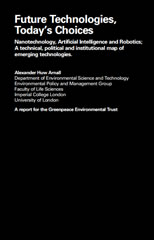
Author : Arnall Alexander Huw
Title : Future technologies, today's choices Nanotechnology, Artificial Intelligence and Robotics; A technical, political and institutional map of emerging technologies.
Year : 2003
Link download : Arnall_Alexander_Huw_-_Future_technologies_today_s_choices.zip
Foreword. Dr Doug Parr, Greenpeace Chief Scientist. Why is Greenpeace interested in new technologies? New technologies feature prominently in our ongoing campaigns against genetic modified (GM) crops and nuclear power; however, they are also an integral part of our solutions to environmental problems, including renewable energy technologies, such as solar, wind and wave power, and waste treatment technologies, such as mechanical–biological treatment. So while Greenpeace accepts and relies upon the merits of many new technologies, we campaign against other technologies that have a potentially profound negative impact on the environment. Greenpeace is in the business of evaluating both future and current threats. Our mission must be to survey upcoming innovations for several reasons. First, we are conscious of unintended (but foreseeable) consequences that impact on the environment. No one intended, for example, that pesticide use in the 1970s and 1980s would have the impact on wildlife that it did. Becoming aware of, and ultimately preventing, the environmental downside of technological developments is clearly a core interest – indeed, the ‘precautionary principle’ has become an important part of international law, such as the Biosafety Protocol on GM organisms. There is also increasing interest in the wider concept of precaution, which is now recognised to include the need for wider participation in the control and direction of technological innovation. This kind of process produces not only a better evidence base, but also more informed decisions. Unintended consequences of a particular new technology cannot always be foreseen; however, if these consequences become a collective problem, it is unreasonable to expect collective responsibility if the decision to proceed with the technology was made by an elite few. Second, and more subtly, the interests of those who own and control the new technologies l a rgely determine how a new technology is used. Any technology placed in the hands of those who care little about the possible e n v i ronmental, health, or social impacts is potentially disastrous. When entire national economies are adapted to take advantage of the economic opportunities off e red by new technologies, it is a matter of huge public i m p o rtance, and the potential enviro n m e n t a l and social consequences are clearly of i m p o rtance to Greenpeace. Global technologies can, particularly in the long term , be of greater significance than Prime Ministers or presidents. Will the power aff o rded to people and organisations in control of these new technologies be properly controlled? If a single person – a computer- v i rus writer or a biochemist dealing with anthrax – can cause huge political and financial problems, how much more damage could those with more re s o u rces do? Thorough public scrutiny before financial or political commitments to new technologies become irreversible could be hugely beneficial, and surely a matter of democratic rights. In April and May 2002, Greenpeace and New Scientist magazine co-sponsored a series of four debates on the impacts of new technologies, entitled Science, Technology and the Future. These debates generated much interest, but the difficulties in locating speakers highlighted the fact that few people could give an overview of either developments in these technologies or their impact in the physical, political and commercial domains. Even more problematic was identifying what the initial technological products would be and their social or environmental consequences. This prompted Greenpeace to commission a comprehensive review of nanotechnology and artificial intelligence/robotics developments from an organisation with a reputation for technological expertise – Imperial College London. We asked them to document existing applications and to analyse current research and development (R&D), the main players behind these developments, and the associated incentives and risks. ...

Demolins Edmond - L'éducation nouvelle
Auteur : Demolins Edmond Ouvrage : L'éducation nouvelle Année : 1898 Lien de téléchargement :...














